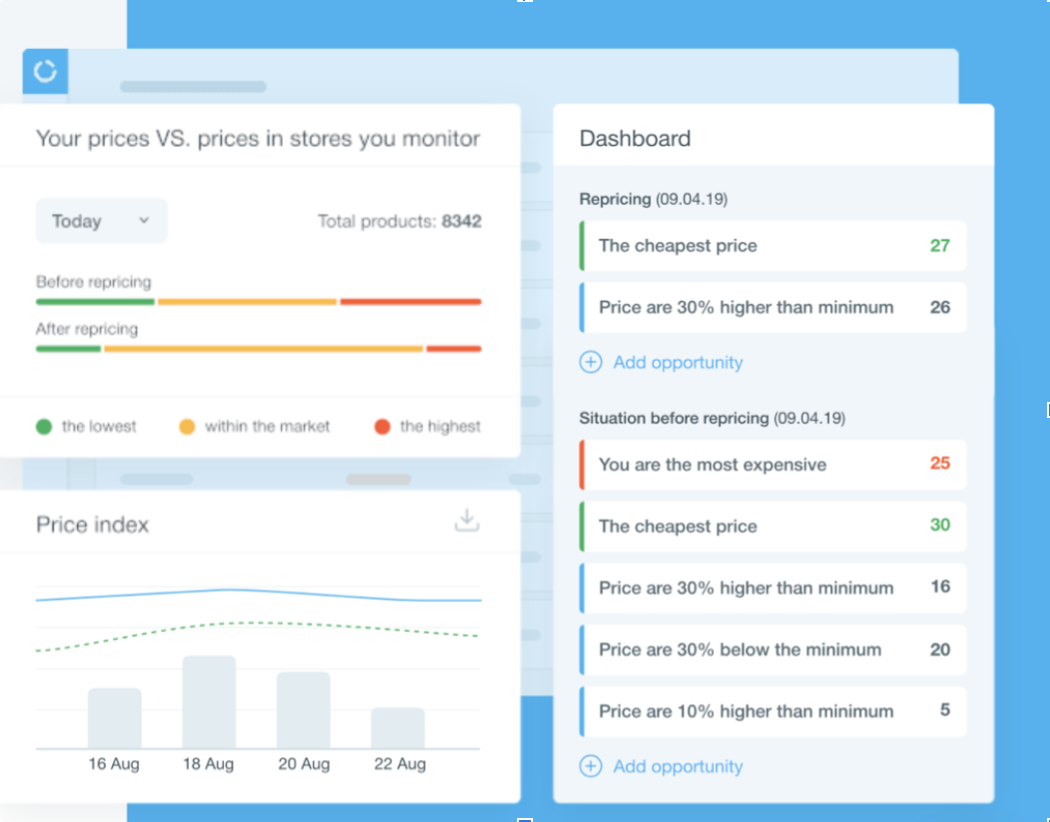What is Price Comparison Software?
Price comparison software, be it in-house development or a third-party service, is a digital tool designed to check and compare software prices of your competitors for any product in your portfolio. In essence, the performance of such a tool is evaluated based on three crucial factors:
- Speed.
- Data and crawling accuracy.
- Functionality (the ability to work at different sites and platforms such as google shopping or Amazon with different product data).
These online price comparison tools are indispensable for retailers who deploy competitive and market-based pricing strategies in their business activities. With the in-depth knowledge they provide, retailers can stay ahead of rivals, respond timely to price changes, devise further tactical steps, and construct specific strategies for unique products to attract new customers.
Choosing the best price comparison tool is easier said than done. Several price checking software tools exist on the market, and from a surface-level point of view, they all tend to offer the same product for your company. However, key differences exist between the price comparison software providers you may find. This article will help you identify important factors that can differentiate between an adequate price comparison tool and an excellent one, so that you may select the best software according to your company's needs and goals.
Why Should I Use a Price Comparison Tool?
One might wonder why the use of a price comparison tool is so essential. The answer lies in the current competitive digital market. Ecommerce has grown exponentially, and with it, so has the competition. With an abundance of options at their fingertips, customers have become more discerning. They can quickly check and compare prices across different online platforms before making a buying decision.
As a retailer, a price comparison tool can be your ally in this competitive landscape. It helps in comparing software prices in real-time, offering you insights into how your prices stack against those of your competitors. Finding your best price comparison tool also enables you to adjust your pricing strategy promptly, ensuring you remain competitive without compromising on profit margins.
What are the Advantages of Using a Price Comparison Tool?
Using a price comparison tool, such as Competera or other highly rated options in the global market, brings several benefits.
First, it saves time. Manually checking each competitor's prices for every product you offer would be time-consuming and inefficient. A price comparison tool automates this process, providing you with all the information you need at a glance.
Second, it increases accuracy. Humans are prone to error, particularly when handling large amounts of data. A comparison tool eliminates this risk, offering you precise and reliable data.
Third, it allows for dynamic pricing. As the market fluctuates, a price comparison tool enables you to adapt your prices accordingly, ensuring you remain competitive.
Lastly, it provides valuable insights. A price comparison tool does more than just compare prices; it can also analyze trends, identify your real competitors, and offer market insights that can help boost your sales and margins.
How to Analyze the Data After the Price Comparison?
Once you've gathered the data using a price comparison tool, the next step is to analyze it effectively. Here's how:
Identify Trends: Look for patterns in pricing among your competitors. Are there specific times when prices tend to go up or down? Understanding these trends can help you anticipate changes and adjust your strategy accordingly.
Know Your Competitors: The data can reveal who your real competitors are. You might find that some businesses you thought were rivals do not significantly impact your sales.
Product Positioning: Data from price comparison can help you position your products effectively. By understanding how your products are priced compared to similar products in the market, you can decide if you want to position your products as a cost-effective option or as a premium choice.
Customer Behavior: The data can provide insights into customer behavior. By analyzing how price changes impact sales, you can understand more about what your customers value and how price-sensitive they are.
How does price comparison software work?
The flow of a price comparison tool can be described as an action of five stages, some of which are repeated cyclically. The picture below illustrates the operation algorithm of the basic solution from Competera, which we call Competitive Data.

During the first stages, the retailer provides data on the products they’re going to monitor. An effective price comparison solution is able to adapt to the client’s current operating activities. That is, use the following formats, sources as well as flows of where this data is stored and how it proceeds.
Once the data is obtained, the comparison process begins. Depending on the retailer’s needs, modern systems can compare prices as well as EAN, UPC, images, titles, descriptions, units of measurement, etc. Each received data point (comparison product vs. product) goes through two levels of verification, confidentiality scoring system, and manual QA. For example, in Competera, each client can choose automatic, manual, or hybrid product matches.
Finally, the received data are delivered to the storage the client works with. For example, to a separate cloud project using Google BQ, Amazon S3, or to the client’s server. In all of the cases, all matches and info are available from the user’s dashboard.
The most exciting thing is that the price comparison is just the tip of the iceberg. This data stores much more valuable information, which can be processed by modern ML-systems. Here are just a few examples of what you can learn from the obtained data points. You can:
- Find out who your real competitor is and how different players impact your sales.
- Find out the recommended first price on your new products.
- Arm your team with the market insights on how to increase sales or margin.
How to choose the best price compare site tool
The most important aspect of choosing the best price comparision tool comes down to the seemingly minor aspects of how the tool being offered works. They are far more critical than it may seem at first, and also may be difficult to identify at a glance. When you are taking a look at the software being presented to you, take careful consideration into the following details:
Data Quality: The data collected and analyzed by any price comparison tool forms the foundation of your pricing strategy. You should find out how accurate the data provided by the tool is.

Also try to find out how often this data is checked for accuracy, and when it is delivered to you. Many eCommerce retailers utilize dynamic pricing, meaning they change their prices up to several times per day. Your software provider may be giving you very accurate data that was collected at noon each day, but if you’re comparing and changing your own prices at 3 pm, this data may already be out-of-date and, therefore, much less useful to you for price comparison. Ideally, as a retailer, you should be able to request your data at the exact time that you need it.
Read through the SLA. Your service level agreement is vital in understanding exactly what this price comparison tool can guarantee you in terms of quality, accuracy, delivery, and customer support. Ask yourself the following questions:
- What is the minimum/maximum accuracy rate this company can promise me in their SLA?
- Does the SLA state that the data provided to me can be customized according to my needs? Can you change what competitors you are comparing prices with when you need to, or are they giving you large, general data-dumps of information on companies you do not need to be paying for?
- Do they offer a pay-per-use model so you can avoid unnecessary costs? How accessible is their customer support service?
All of these questions are vital in understanding not only the quality of the price comparison tool in general, but also the dedication the provider has to your company and their ability to customize their product so you can really enjoy the best price compare site software.
User-friendliness. The main objective of a price comparison tool in regards to your pricing strategy is to save you time and money. If the platform the software provider offers is difficult and time-consuming to use, it should be a huge red flag for you that it may not be worth its cost.
Profitability. Your price comparison software exists to save you time and money. If the software isn’t easily integratable into your current pricing strategy, you could end up investing far more funds into using the software than what it’s worth. Typically, you should be able to try some sort of demo or trial of the software, which can help you determine how profitable it will be for your company, and whether or not it is worth the investment.
Does my business need the price comparison solution?
Recent research has shown how price changes influence consumers’ buying decisions. The good news is that e-commerce retailers benefit from the comparison tools the most. This type of software fits both retailers selling to the end customer and vendors who, for example, can monitor adhering to MAP by their customers. Moreover, even if you are selling a unique product, today's technology can match and compare similar products (e.g., by color or functionality) and give you a complete picture of the market.
On the other hand, if your business is fully offline, we recommend considering other, even more advanced, pricing strategies without the need to use competitive data.
Choose your software wisely
If you want to remain competitive in the market and ensure that you are always providing the best prices for your products, a price comparison tool can help you do so whilst maximizing your sales and increasing profit in the process. Not all price comparison software is the same, though, so keep in mind these important factors that can really make or break the usefulness and profitability of any price comparison tool. Hopefully, with this knowledge, you can select the best price comparison tool according to your company’s objectives.
FAQ
The best way to compare prices implies the use of price comparison websites and tools. However, they work only for online shops while there are no such means for brick-and-mortar stores.
The cheapest price for a product could be found on price monitoring websites or online marketplaces.






